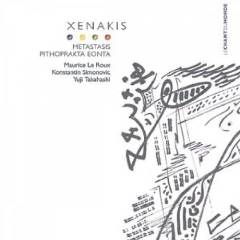Iannis Xenakis - Metastasis Pithoprakta Eonta (1965)
Iannis Xenakis - Metastasis Pithoprakta Eonta (1965)

1. Eonta, for 2 trumpets, 3 trombones & piano: Première Partie 2. Eonta, for 2 trumpets, 3 trombones & piano: Deuxième Partie 3. Metastasis, for 60 musicians (Anastenaria, Part 3) 4. Pithoprakta, for 49 musicians Paris Contemporary Music Instrumental Ensemble Konstantin Simonovic – conductor (1,2) ORTF Philharmonic Orchestra Jean-Louis Le Roux – conductor (3,4)
This disc contains recordings from the 1960s of three pieces by Iannis Xenakis performed by two French ensembles, the ORTF conducted by Maurie Le Roux on the orchestral works, and the Ensemble Instrumental de Musique Contemporaine de Paris conducted by Konstantin Simonovic on the chamber work. Xenakis is one of the most fascinating of twentieth-century composers. An outsider to the avant-garde establishment whose day job was architecture, his main passion was mathematics. He had no interest in traditional melody or harmony, but rather sought to create music out of the most complicated notions. His teacher Olivier Messiaen spurred him to continue on in this vein, noting that he was doing something no one else had before. Yes, Xenakis' work is rigourously mathematical, but it sounds not cold and dispassionate, but eye-opening and expansive.
"Metastasis" (1953-1954) is probably Xenakis' best-known piece, and his first mature work. It is a piece of great proportions, 61 instrumentalists playing 61 different parts. The opening is stunning, gradually each of the strings enters sustaining a single note, creating a massive wall of sound before some strings go astray to other notes and pizzicato playing and the rest of the orchestra shows up. Closely related to the composer's design of the Couvent de la Tourette near Lyons, much of the dynamics of this first portion is based on the Fibonacci sequence, with nearly every decision in the work, from the structures of intervals to the length of dynamics and tones. The second section is more traditional, as the bulk of the orchestral forces remain silent with some strings playing a contrapuntal passage with drumrolls in the background and the occasional spotting of brass. Even though this is an AAD recording, the sound quality is superb, with next to no hiss and wonderful dynamics. "Metastasis" sounds way better here than the SWF-Symphony Orchestra/Hans Rosbaud recording on Col legno, the other big historical performance of the work.
"Pithoprakta" (1955-1956) was Xenakis' follow-up to "Metastasis", and sets off on a new course that was to concern the composer for several years. Gone is the inspiration of the Fibonacci sequence, and instead Xenakis creates music of *probabilities*. As a result, the music sounds less focused (think of Lutoslawski's "hesitant" music on steroids), but ultimately richer in timbre and rhythm. The piece's opening consists of the string players knocking on the bodies of their instruments, only the first in a series of explorations of texture, rich with pizzicato, glissandi, trombones sounding, and even woodblock percussion. Even though this is arguably random music, there's such a pulse of life here that even conservative listeners might find themselves won over. A similar piece is "Eonta" for piano and brass quintet (1963), influenced by the ST series of small probabilistic compositions Xenakis had made in the previous years, but written more freely. The piano part is very stochastic, creating music which is remarkable in sound to Boulez's second piano sonata even though it is not serial. The brass interrupt the piano's course from time to time, and exhibit microtonal sounds that contrast with the fixed pitches of the piano. This is the only piece on the disc I don't enjoy, for it is overlong and the instrumentation doesn't work, especially when it comes right after the grandeur of Xenakis' writing for orchestra.
If one wants an introduction to the entire breadth of Xenakis' career, the recent Col legno disc ("Orchestral Works and Chamber Music") is probably the best choice, but for fantastic performances of Xenakis' riotously original early works look here. --- Christopher Culver, amazon.com
download: uploaded yandex anonfiles 4shared ziddu sygarsync mediafire gett
Last Updated (Friday, 03 May 2013 16:24)








